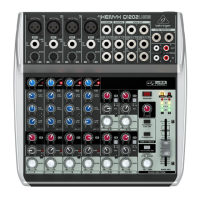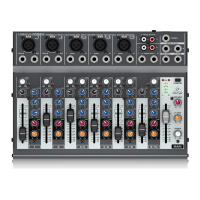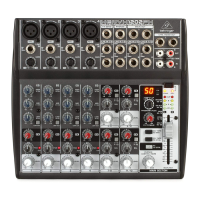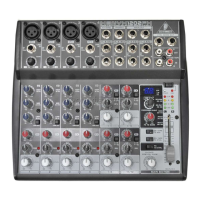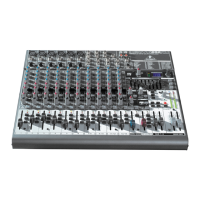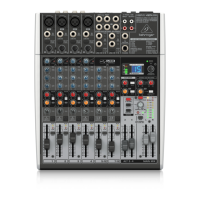Q802USB and Q502USB do not feature this switch.
23. +48 V – The red +48 V LED lights up when phantom power is on. The PHANTOM switch activates the phantom power
supply on the XLR connectors of all mono channels.
24. POWER – The POWER LED indicates that the console is powered on.
25. LEVEL INDICATOR – The high-precision 4-segment display accurately displays the relevant signal level.
26. COMP – This knob adjusts the amount of compression effect on the channel.
27. PHANTOM – Press this knob to send +48 V of phantom power to the XLR inputs for use with condenser microphones.
The Q502USB supplies +15 V of phantom power.
28. USB/2-TR TO PHONES/CTRL RM – button routes USB/2-Track playback to PHONES/CTRL ROOM.
29. USB/2-TR TO MAIN MIX – button routes USB/2-Track playback to MAIN MIX and mutes the 2-TR OUT/USB recording
signal.
30. USB CONNECTOR – Connect your mixer to a computer using a standard USB cable.
31. AC POWER IN – Connect the included power cable here.
The mixer cannot be bus-powered via USB. Always use the included power adapter to supply power to the mixer.
Step 3: Level Setting
To correctly set the gains of the channels, first set the LEVEL controls of the input channels to their center positions (0 dB).
Then use the GAIN controls to increase the input amplification until signal peaks show 0 dB on the level meter.
When recording to digital recorders, the recorder’s peak meter should not go into overload. While analog recorders can be
overloaded to some extent, creating only a certain amount of distortion (which is common and often desirable), digital recorders
distort quickly when overloaded. In addition, digital distortion is not only undesirable but also renders your recording completely
useless. The peak meters of your XENYX display the level virtually independent of frequency. A recording level of 0 dB is
recommended for all signal types.
Mono Inputs
Microphone Inputs
Type XLR connector, balanced, the discrete input circuit
Mic E.I.N. (20 Hz – 20 kHz)
@ 0 Ω Source resistance -134 dB / 136 dB A-weighted
@ 50 Ω Source resistance -131 dB / 133 dB A-weighted
@ 150 Ω Source resistance -129 dB / 131 dB A-weighted
Frequency Response (-1 db) <10 Hz – 150 kHz (-1 db)
Frequency Response (-3 db) <10 Hz – 200 kHz (-3 db)
Gain range +10 dB to +60 dB
Max. input level +12 dBu @ +10 dB Gain
Impedance 1.9 kΩ balanced 1.9 kΩ balanced 1.9 kΩ balanced 1.4 kΩ balanced
Signal-to-noise ratio 110 dB A-weighted (0 dBu In @ +22 dB Gain)
Distortion (THD+N) 0.005% / 0.004% A-weighted
Line Inputs
Type ¼” TRS connector, balanced
Impedance 20 kΩ balanced, 10 kΩ unbalanced

